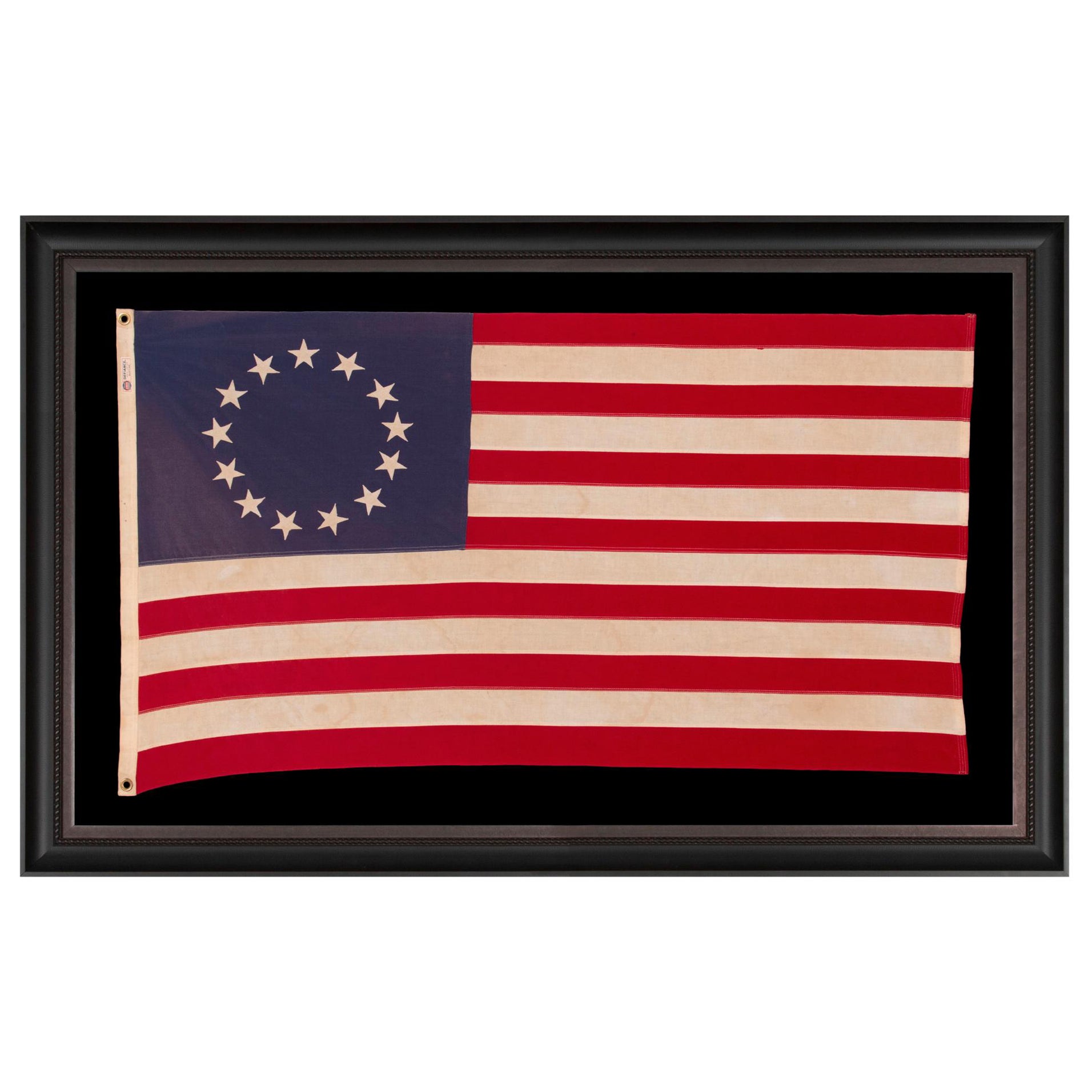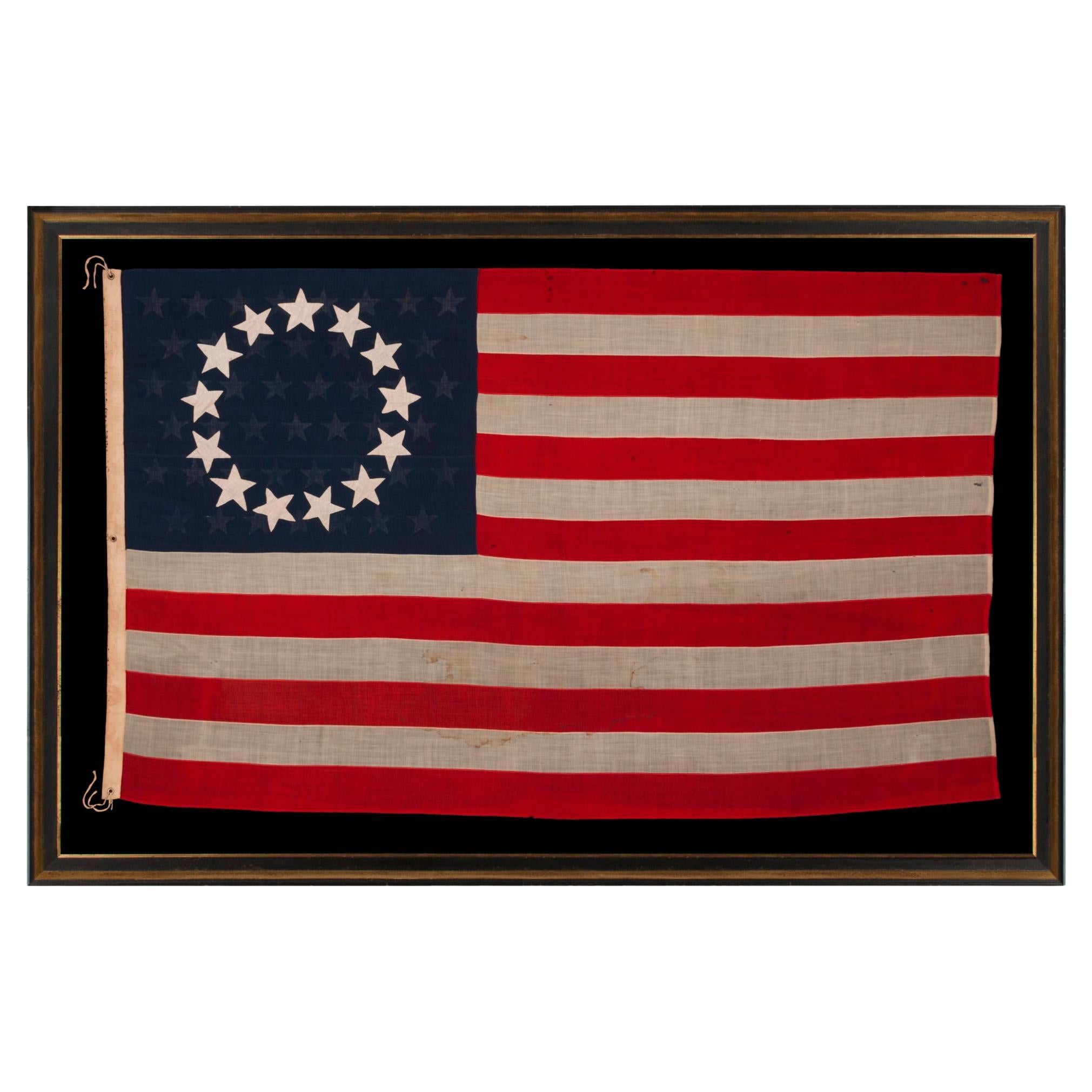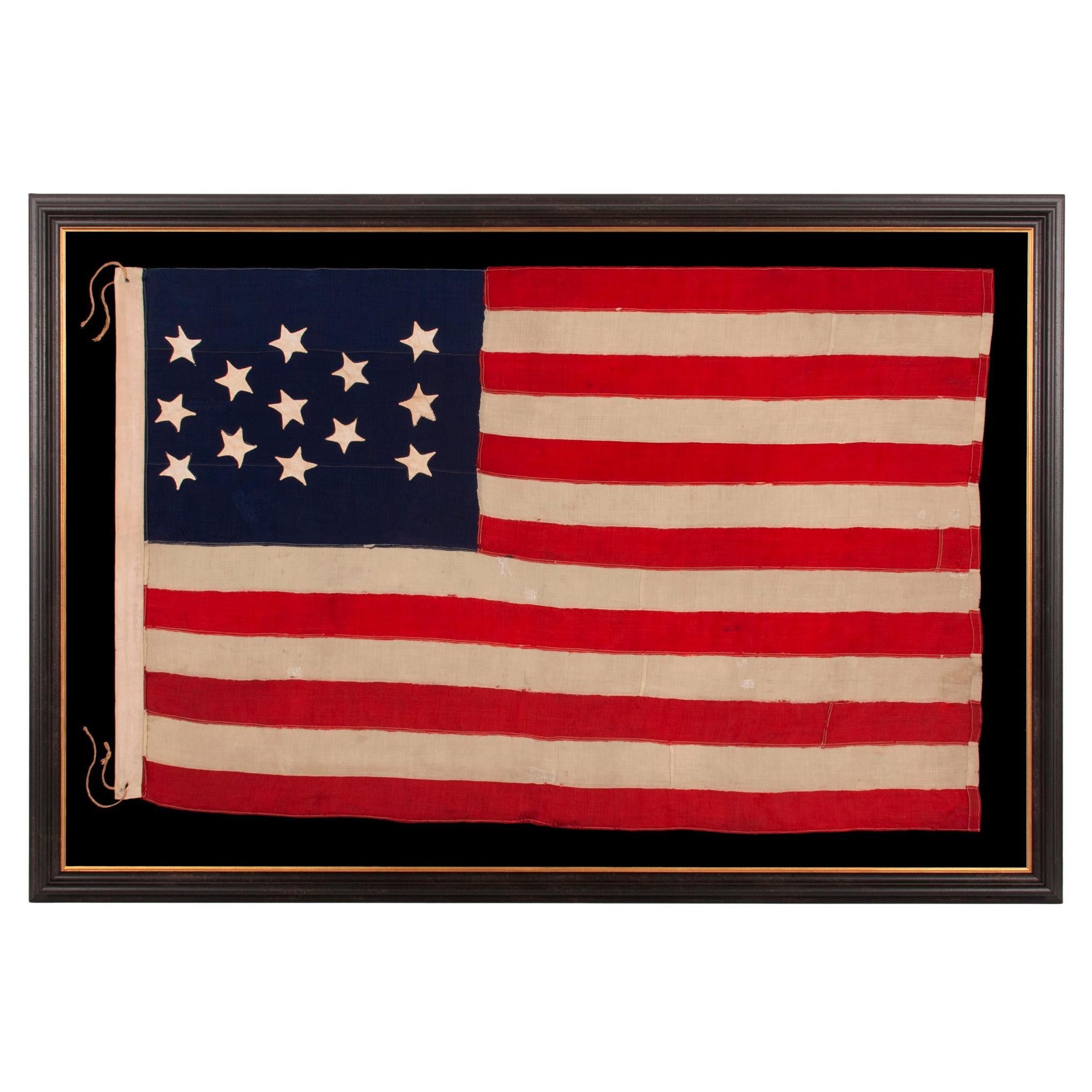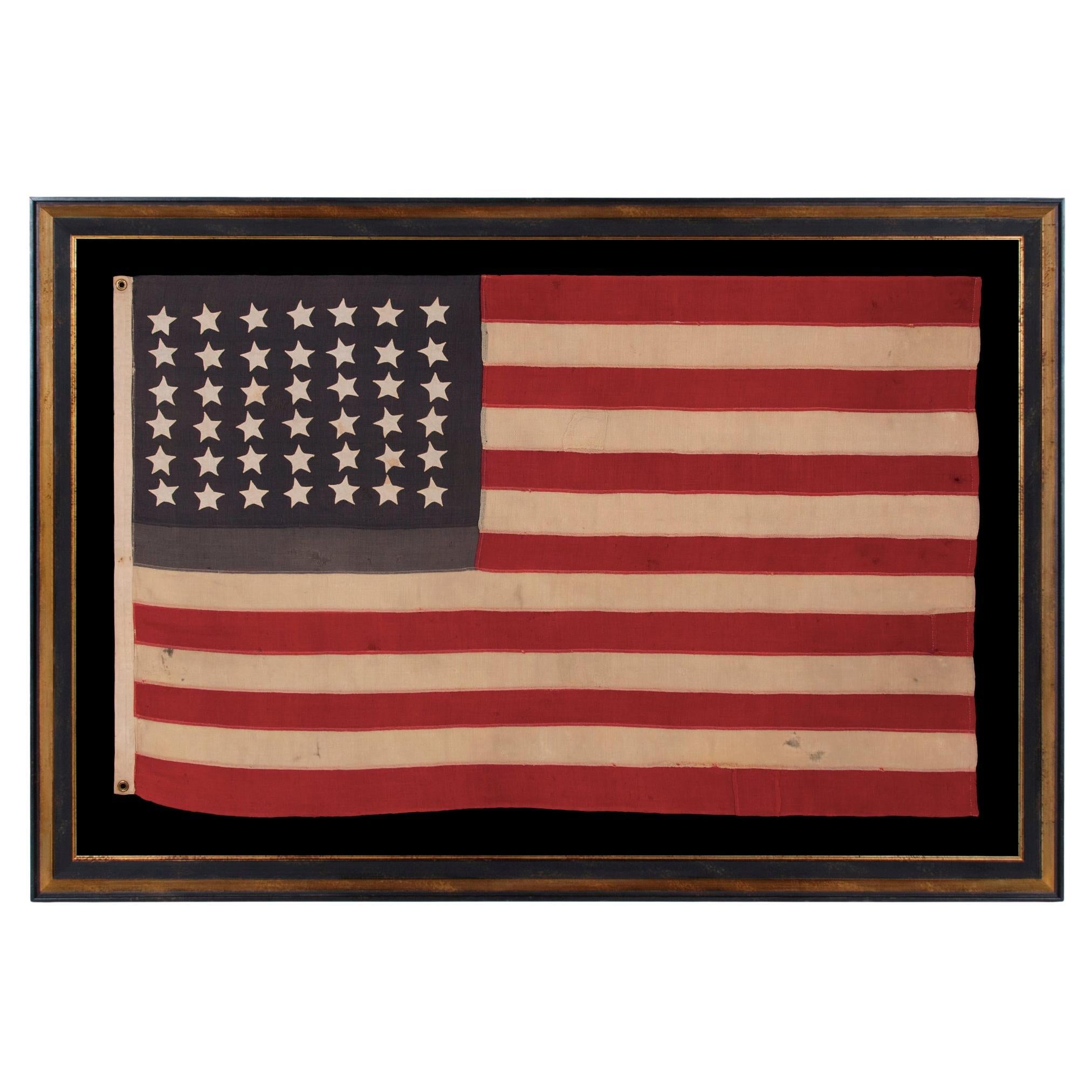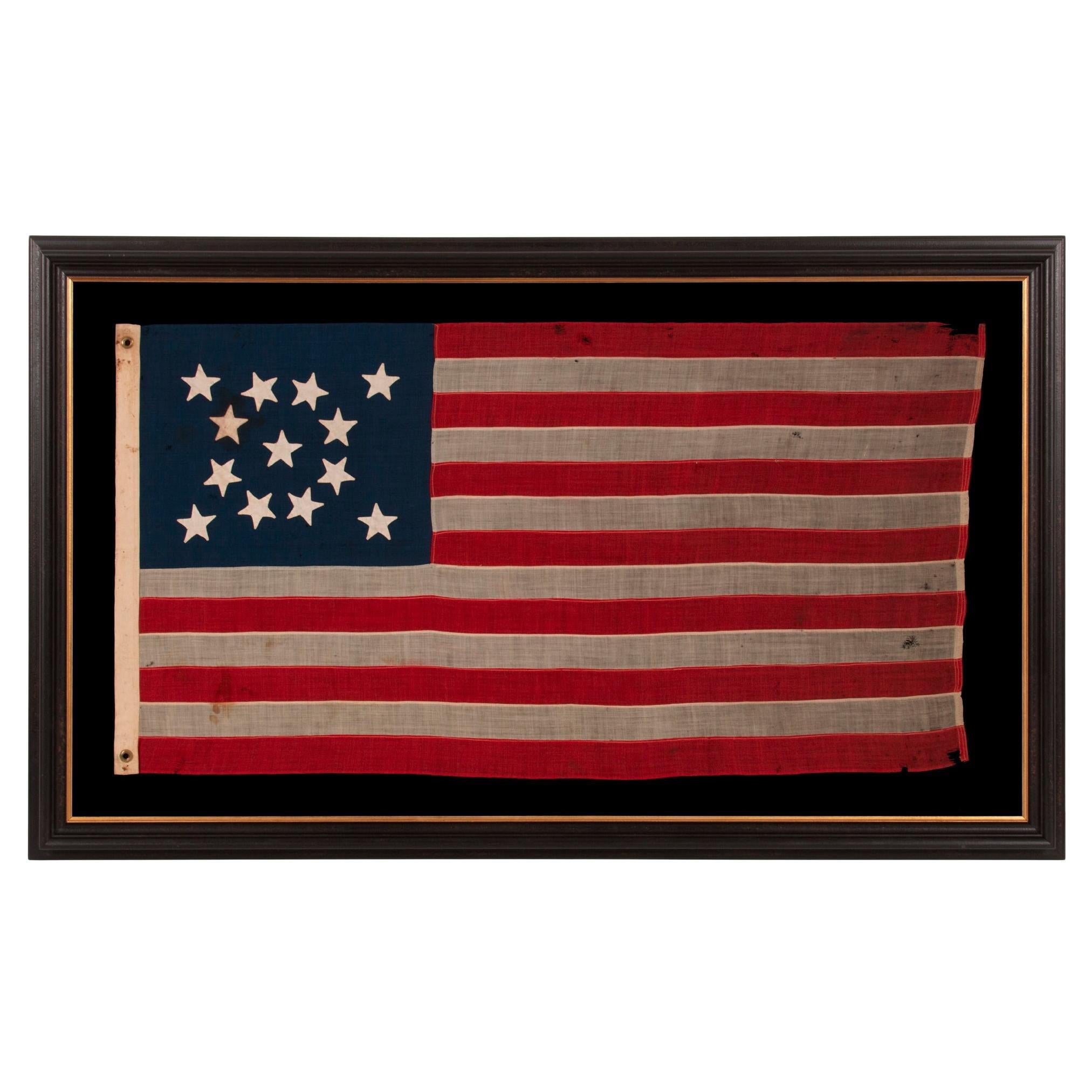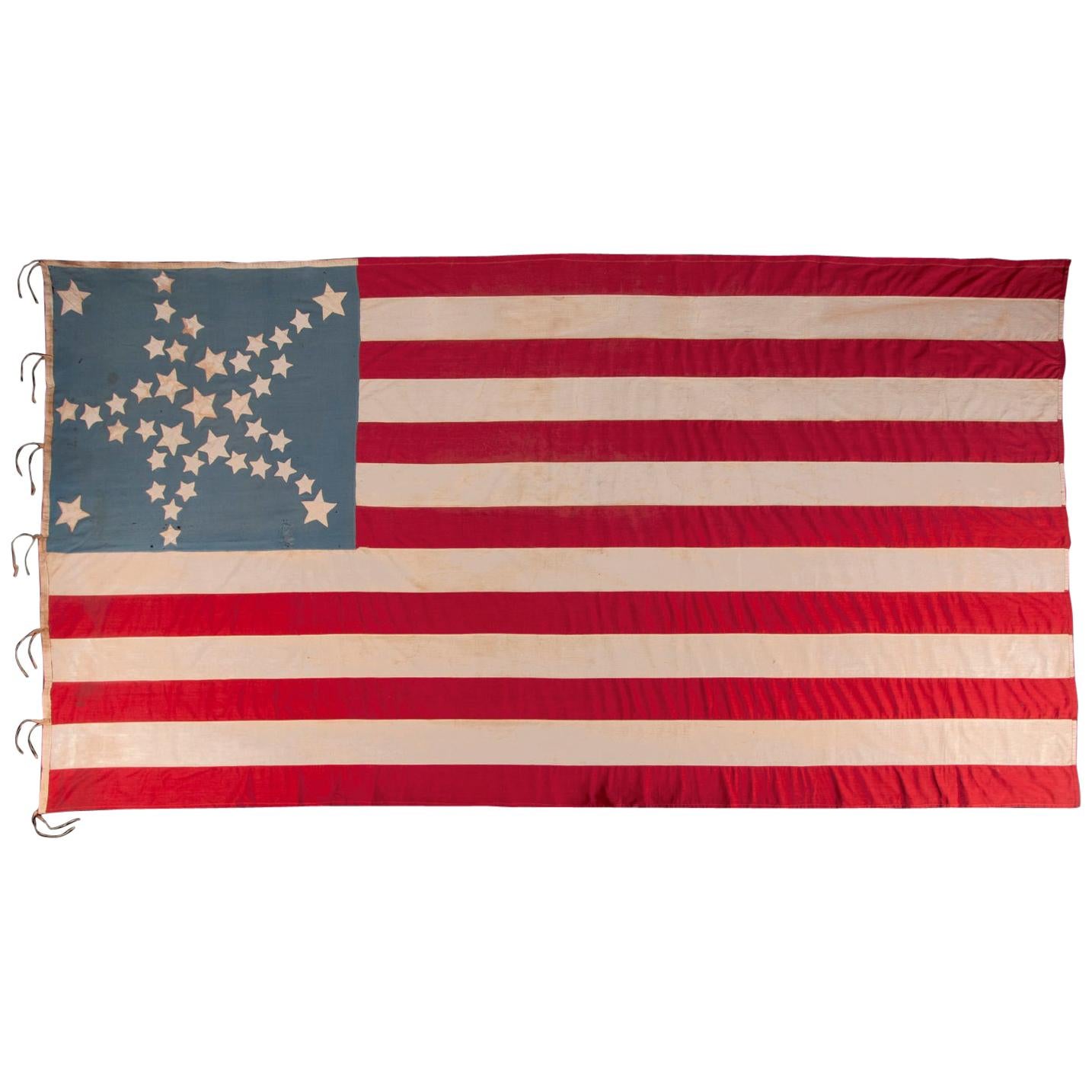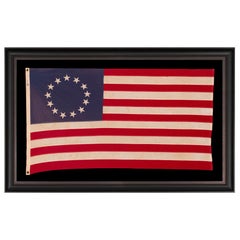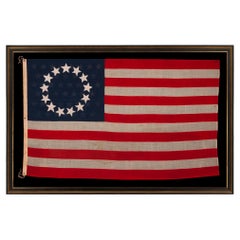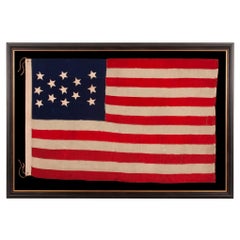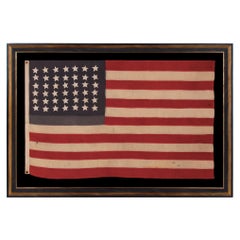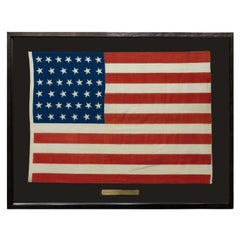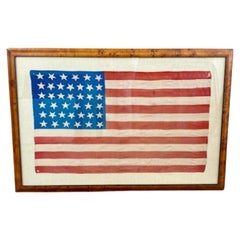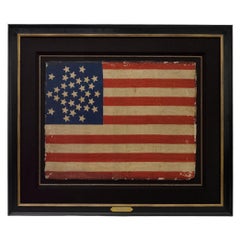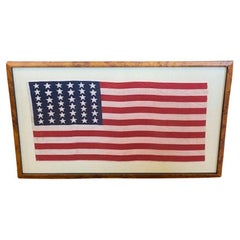Articoli simili a 13 Stars in a Betsy Ross Pattern, ca 1910-1926
Vuoi altre immagini o video?
Richiedi altre immagini o video al venditore
1 di 7
13 Stars in a Betsy Ross Pattern, ca 1910-1926
Prezzo su richiesta
Informazioni sull’articolo
13 STARS IN THE BETSY ROSS PATTERN ON A SMALL-SCALE ANTIQUE AMERICAN FLAG MADE SOMETIME BETWEEN APPROXIMATELY 1910 AND THE 1926 SESQUICENTENNIAL OF AMERICAN INDEPENDENCE
13 star flag of the type made from roughly the last decade of the 19th century through the first quarter of the 20th. The stars are arranged in the circular wreath pattern most often associated with Betsy Ross. Flags in this design are widely admired, due to the longstanding popularity of the Betsy Ross myth. While many Americans were taught in grammar school that this was what our first flag looked like, there is unfortunately no way to prove the claim. No colonial examples have survived with this pattern of stars. In fact, I have encountered just three surviving examples of Betsy Ross pattern flags that I believe to pre-date the 1890's.
Because there was no official star pattern for the American flag until 1912, just after New Mexico and Arizona entered the Union as the 47th and 48th states, the arrangement before that time was completely left to the liberties of the maker. As a result, there are more than 80 known star patterns for the 13 star count alone.
The canton and stripes of the flag are made of wool bunting that has been pieced with machine stitching. The stars are made of cotton and double-appliquéd (applied to both sides) with a zigzag machine stitch. There is a twill cotton binding along the hoist with three white metal grommets, along which “2 x 3” appears in a black-inked stencil, near the top, on the obverse, to indicate size in feet. Adjacent to this and perpendicular to it, the number “11” is inscribed in black, while “No. 11” appears on the reverse of the binding in teal blue grease pencil. Near the top, a penciled inscription, difficult to decipher, reads “Betsy Ross.” Together the elements of the flag’s construction point to the period between approximately 1910 and the 1926 Sesquicentennial of American Independence.
Why 13 Stars? As the number of stars grew with the addition of new states, it became more and more difficult to fit their full complement on a small flag. The stars would, by necessity, have to become smaller, which made it more and more difficult to view them from a distance as individual objects. The fear was that too many stars would appear as one white mass, at a distance and distort the ability to identify American ships on the open seas.
The U.S. Navy flew 13 star flags on small craft for precisely this reason. This was, of course, the original number of stars on the first American national flag, by way of the First Flag Act of 1777, and equal to the number of original colonies that became states. To the Navy, a small flag generally meant anything short of 10 feet. Prior to the 1890’s, the smallest sewn flags encountered with any regularity were approximately 6 feet on the fly. Because the primary use had long been more utilitarian than decorative, flags needed to be large to be effective as signals. Private use grew with the passage of time, however, as did worldwide ability to recognize the American flag, both of led to the production of flags of smaller scale.
In 1864, the newly released regulations for U.S. Navy small boat ensigns assigned each specified size with a numeric designation. In 1864 and 1870 regs, a No. 11 ensign measured 4.2 feet on the hoist by 8 feet on the fly. This size designation was removed until 1914, when it reappears with corresponding measurements of 2.37 x 4.5 feet. In neither instance does this correlate with the 2 x 3 foot specs of the Betsy Ross pattern flag that is the subject of this narrative. The Navy made its own flags at various locations, some of which were marked and dated. Because they sometimes acquired them simultaneously from commercial makers, ships’ chandlers and other sources, all of which appear to have loosely followed Navy specs in such instances—or else the Navy remained flexible, perhaps caring more about expediency and price, actual measurements varied greatly. This is hardly the only time that I have seen Navy designation on a flag stenciled with measurements that only loosely correspond.
Beginning around 1890, commercial flag-makers began to produce smaller flags for the first time in large quantities. These typically measured either 2 x 3 feet (like this example), or 2.5 x 4 feet. Applying the same logic as the Navy, they selected the 13 star count rather than the full complement of stars, for the sake of ease and visibility. Any flag that has previously been official remains so according to the flag acts, so even today 13 star flags remain official national flags of the United States of America.
One of the interesting misconceptions about 13 star flags is that an open, circular wreath pattern, even if not the original design, must have been common in early America. Logic would suggest this, given the frequency with which it appears in modern times. This was not the case, however; in fact, the pattern is seldom encountered anywhere until much later. Exceptions include a 1779-1780 painting of George Washington at the Battle of Princeton, by Charles Willson Peale, that depicts, in the background, a flag that appears to have a circular wreath of stars, but no stripes. This is one of the few appearances of a circular pattern in a work period to the Revolutionary War, yet it wasn’t the national flag and Peale may have used some artist’s liberty in its inclusion. While known to be especially detailed and keen on accuracy, Peale made at least four copies of the painting prior to 1782, one of which shows the Battle of Trenton in lieu of Princeton (the original), so he obviously wasn’t opposed to alterations. Trumbull, included a flag with what may be a circular pattern in a 1787 painting of the Battle of Yorktown, but the flag is waving and it is not known if the intended design was to be circular or oval.
Francis Hopkinson, credited designer of the Stars & Stripes, actually rendered a circular pattern of 13 eight-pointed stars, presented like the rowels of a spur, on a piece of 1778 Philadelphia currency. This did not show a flag and was not part of one. He included a similar rendering, surrounding a liberty cap, on a 1778 draft for the seal of the U.S. Board of War, but there is a flag affixed to the liberty pole on which the cap rests, and the flag, which displays only stars, arranges them in a 4-3-4-2 lineal pattern.
The only surviving 18th-century illustration of a 13 star, Stars & Stripes with a circular wreath and no center star, appears in a sketch by William Barton, which served as his 2nd draft for the Great Seal of the United States, presented to the 3rd Committee designated to select it. Though it does not survive, Barton’s first draft is also said to have included such a flag. The final draft was not rendered by Barton, but by Congressional Secretary Charles Thompson, who included no flags, but did include an arrangement of 13 stars above the head of a federal eagle, placed in a random pattern. It is of interest to note that Francis Hopkinson produced some of the initial drafts of the seal, which also included 13 stars in a random scatter (fig. 4).
One of the best arguments against the Betsy Ross pattern having appeared on the original flag is illustrated by the fact that so many 13 star flags exist without it. If the Ross design was the original, it stands to reason that the pattern would have been reproduced with at least some degree of frequency.
Research conducted by the National Museum of American History notes that the story of Betsy Ross making the very first American flag for General George Washington, in the company of George Ross and Robert Morris, entered into American consciousness about the time of the 1876 centennial. The tale was immensely popular among an American public eager for stories about the Revolution and its heroes. The first documentation of the narrative appeared shortly beforehand, in 1870, in a paper written by Betsy’s grandson, William Canby, for the Pennsylvania Historical Society. At the time Canby made no mention of how the flag was designed, save for the fact that it had 5-pointed stars, per his grandmother’s suggestion. Because no earlier documentation supports the story, most flag scholars feel it was a grand hoax, fabricated by Canby for his own interests. Nothing survives in the collective writings of the three men, for example, nor in records of their words and deeds, which are fairly extensive. As with most things, reality is perhaps somewhere in the middle ground, with some of the details based on fact and some on fiction, made up, misinterpreted, or imagined from family accounts.
The first time that a star configuration gets attached to the Ross story appears to have occurred during the last decade of the 19th century. In 1892, Charles Weisgerber painted a nine-by-twelve-foot rendition of the fabled meeting between Betsy and George Washington, in which there is a flag with a circular wreath. Shortly afterwards, in 1898, Betsy’s granddaughter and great-granddaughter began to make flags in the East Wing of Independence Hall in Philadelphia, selling them to tourists while disseminating family folklore. In that same year, Weisgerber and a “group of concerned citizens” sought to preserve Betsy’s former Philadelphia residence at 239 Arch Street, where she lived at the time the flag would have been sewed. Weisgerber moved his family into the house and immediately opened to the public the room in which Betsy was said to have worked her magic. Ten-cent memberships were sold to fund renovations and donors received a small calendar, to which a cotton 13 star Betsy Ross pattern parade flag was affixed. The effects of these events caused the Ross legend to stick and the story, with the corresponding flag design, has appeared ever since in more places than one could ever hope to count.
Mounting: For 25 years we have maintained our own textile conservation department, led by a master’s degree level graduate from one of the nation’s top university programs. We take great care in the mounting and preservation of flags and related textiles and have preserved thousands of examples.
The background is 100% cotton twill, black in color, that has been washed and treated for colorfastness. The black-painted, hand-gilded and distressed molding is Italian. The glazing is U.V. protective Plexiglas.
Condition: There is extremely minor spoiling along the hoist binding, but there are no significant condition issues.
Frame Size (H x L): Approx. 36" x 49"
Flag Size (H x L): 24" x 37"
- Dimensioni:Altezza: 91,44 cm (36 in)Larghezza: 124,46 cm (49 in)Profondità: 6,35 cm (2,5 in)
- Materiali e tecniche:
- Periodo:
- Data di produzione:1910-1926
- Condizioni:See Item Description.
- Località del venditore:York County, PA
- Numero di riferimento:Venditore: 13j-17151stDibs: LU849745343272
Informazioni sul venditore
5,0
Venditore riconosciuto
Questi venditori prestigiosi sono leader del settore e rappresentano il massimo in termini di qualità e design.
Fondazione nel 1991
Venditore 1stDibs dal 2008
70 vendite su 1stDibs
Tempo di risposta standard: Da 1 a 2 giorni
- SpedizioneRecupero del preventivo…Spedizione da: York County, PA
- Politica di reso
Alcune parti di questa pagina sono state tradotte automaticamente. 1stDibs non può garantire che le traduzioni siano corrette. L’inglese è la lingua predefinita del sito.
Garanzia di autenticità
Nell’improbabile caso in cui si verifichi un problema con l’autenticità di un articolo, contattaci entro un anno per ottenere un rimborso completo. DettagliGaranzia di rimborso
Se il tuo articolo non corrisponde alla descrizione, è danneggiato durante il trasporto o non arriva, contattaci entro 7 giorni per un rimborso completo. DettagliAnnullamento entro 24 ore
Hai un periodo di tolleranza di 24 ore per annullare il tuo acquisto, senza necessità di fornire spiegazioni.Venditori professionali selezionati
I nostri venditori di livello internazionale devono aderire a rigorosi standard di servizio e qualità, garantendo l’integrità delle inserzioni.Garanzia miglior prezzo
Se scopri che un venditore ha pubblicato altrove lo stesso articolo a un prezzo più basso, applicheremo lo stesso prezzo.Consegna globale affidabile
La nostra rete di vettori leader del settore offre opzioni di spedizione specializzate in tutto il mondo, inclusa la consegna personalizzata.Altro da questo venditore
Mostra tutto13 Bandiera a stelle, modello Betsy Ross, prodotta dalla Annin Company, 1955-1965 ca.
13 STELLE NEL MODELLO DI BETSY ROSS, SU UNA BANDIERA AMERICANA D'EPOCA, FATTA DALLA SOCIETÀ ANNIN DI NEW YORK & NEW JERSEY, circa 1955 - 1965
Bandiera nazionale americana a 13 stell...
Categoria
Fine XX secolo, Americano, Memorabilia politici e patriottici
Materiali
Cotone
Bandiera americana antica con 13 stelle nel disegno di Betsy Ross e 45 stelle sul rovescio
13 STELLE NEL MOTIVO BETSY ROSS, CON 45 STELLE SUL RETRO; SU UN'ANTICA BANDIERA AMERICANA FATTA E FIRMATA DA UNA BANDIERA NON IDENTIFICATA, ANNIE MAC LACHLAN DI JERSEY CITY, NEW JER...
Categoria
Di antiquariato/d’epoca, Anni 1890, Americano, Altro, Memorabilia politi...
Materiali
Lana, Cotone
Bandiera americana antica a 13 stelle con presentazione a stelle strette, 1876 circa
BANDIERA AMERICANA ANTICA A 13 STELLE CON STELLE CUCITE A MANO IN UNA PRESENTAZIONE ESTREMAMENTE STRETTA DI UNA DISPOSIZIONE 3-2-3-2-3 SU UN CANTONE CHE NON SEGUE L'ESEMPIO, LASCIAND...
Categoria
Di antiquariato/d’epoca, Anni 1870, Americano, Memorabilia politici e pa...
Materiali
Lana
42 stelle cucite a mano su un'antica bandiera americana del 1889-1890 circa
42 STELLE FATTE A MANO SU UN'ANTICA BANDIERA AMERICANA CON CANTONE BLU POLVEROSO A DUE TONI, CHE RIFLETTE L'AGGIUNZIONE DELLO STATO DI WASHINGTON, DEL MONTANA E DEL DAKOTAS, MAI UN C...
Categoria
Di antiquariato/d’epoca, Fine XIX secolo, Americano, Memorabilia politic...
Materiali
Lana
Prezzo su richiesta
Bandiera americana antica a 13 stelle, stelle cucite a mano in un medaglione, 1876 Centenario
BANDIERA AMERICANA ANTICA A 13 STELLE CON UNA CONFIGURAZIONE A MEDAGLIONE DI STELLE CUCITE A MANO E UN BELLISSIMO PROFILO ALLUNGATO, REALIZZATA NELL'EPOCA DEL CENTENARIO DELL'INDIPEN...
Categoria
Di antiquariato/d’epoca, Anni 1870, Memorabilia politici e patriottici
Materiali
Lana
Bandiera americana a 34 stelle, aggiornata a 39 stelle, con stelle in un motivo a grandi stelle
34 STELLE IN UNA STRAVAGANTE INTERPRETAZIONE DEL MOTIVO DELLA GRANDE STELLA, SU UNA BANDIERA DEL PERIODO DELLA GUERRA CIVILE CON UN CANTONE BLU FIORDALISO, AGGIORNATA A 39 STELLE NEL...
Categoria
Di antiquariato/d’epoca, Anni 1870, Americano, Memorabilia politici e pa...
Materiali
Cotone
Prezzo su richiesta
Spedizione gratuita
Ti potrebbe interessare anche
Bandiera americana antica a 39 stelle con motivo a stella "stravagante", 1889
Questa è una bandiera americana non ufficiale a 39 stelle, realizzata a mano e stampata su cotone. La bandiera risale al 1889 e ha una storia unica, grazie al suo raro numero di stel...
Categoria
Di antiquariato/d’epoca, Anni 1880, Americano, Memorabilia politici e pa...
Materiali
Cotone
Bandiera americana a 39 stelle del XIX secolo, circa 1889
Bandiera americana a 39 stelle del XIX secolo, circa 1889, una bandiera da parata in seta stampata d'epoca con un motivo ondulato di stelle danzanti. Questa non fu mai una bandiera u...
Categoria
Di antiquariato/d’epoca, Anni 1880, Americano, Federale, Memorabilia pol...
Materiali
Seta
Bandiera americana stampata a 31 stelle, che celebra la nascita dello Stato della California, circa 1850
Si tratta di una rara bandiera americana stampata con medaglione a 31 stelle, che celebra l'aggiunta della California all'Unione. La bandiera è stampata su seta e presenta uno spetta...
Categoria
Di antiquariato/d’epoca, Anni 1850, Americano, Memorabilia politici e pa...
Materiali
Seta
Bandiera americana a 39 stelle del XIX secolo, circa 1889
Bandiera americana a 39 stelle del XIX secolo, circa 1889, un vessillo di lino stampato con 39 stelle disposte in un motivo a stelle ondulate, con strisce dalla forma allungata molto...
Categoria
Di antiquariato/d’epoca, Anni 1880, Americano, Federale, Memorabilia pol...
Materiali
Lino
Bandiera americana a 45 stelle, stampata su cotone, che celebra la nascita dello Stato dello Utah, 1896-1908
Questa bandiera degli Stati Uniti a 45 stelle celebra la nascita dello Stato dello Utah. Le bandiere a 45 stelle sono state la bandiera ufficiale americana dal 1896 al 1908. Questa p...
Categoria
Di antiquariato/d’epoca, Anni 1890, Americano, Memorabilia politici e pa...
Materiali
Cotone
Bandiera americana stampata a 48 stelle, commemorativa della nascita dello Stato dell'Arizona, 1912-1958
Questa è una bandiera da parata americana originale a 48 stelle, che celebra lo stato dell'Arizona. Un meraviglioso prodotto della storia della nostra nazione, questa bandiera è un a...
Categoria
Metà XX secolo, Americano, Memorabilia politici e patriottici
Materiali
Tessuto
